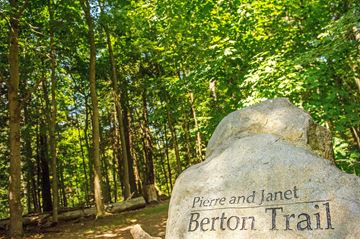Find your Favorite!
Local News: Ontario’s Greatest Cycling Adventure Heads to the Greenbelt
The Great Waterfront Trail Adventure launches 475 km provincial cycling route in Ontario’s Greenbelt
For the first time, one of Canada’s preeminent cycling events, the Great Waterfront Trail Adventure (GWTA), is moving away from the water and into Ontario’s protected countryside. The GWTA is a six‐day ride (August 16‐21) along the 475 km Greenbelt Route, spanningseven regions from Northumberland to Niagara.
The opening of the Greenbelt Route celebrates the 10th Anniversary of Ontario's Greenbelt, and marks a decade of protected green space and fertile farmland.
Cycling tourism is growing in Ontario, and adds nearly 400 million dollars to the economy. Recognizing the importance of cycling not only to the economy but also to the promotion of healthy, active living, the Ontario government recently declared June Bike Month.
“Just as the Waterfront Trail has done, the Greenbelt Route will help boost Ontario’s reputation as a premier cycling destination,” said Marlaine Koehler, Executive Director of the Waterfront Regeneration Trust. “The new route will help serve the growing cycle tourism industry in Ontario, which brings in millions of dollars every year, and give locals and tourists access to attractions, natural landmarks and conservation areas.”
The Greenbelt Route is the result of a three-year initiative funded by the Friends of the Greenbelt Foundation and led by the Waterfront Regeneration Trust in collaboration with the 27 communities through which the route runs. The Canadian Automobile Association (CAA) CAA is a also a supporter of the Adventure.
Riders in the GWTA Special Greenbelt Route Edition will have time to explore those same communities, to shop, taste thelocal wines and foods, and be one of the first to take on the challenge of the brand new Greenbelt Route.
The Canadian Automobile Association (CAA) is a leading supporter of the GWTA and will be providing roadside assistance with CAA Bike Assist, which helps cyclists repair and adjust their bikes when needed.
“Many of our Members are cyclists too, so this partnership makes perfect sense for us. Members can call us for service no matter if they are travelling by four wheels or by two,” said Anna Halkidis, Manager of Roadside Operations at CAA South Central Ontario.
“With our CAA App, including the Service Trackerapp, we can give our Members an even greater experience in safety and service. They can see where their service provider is every step of the way to them, which is undoubtedly reassuring for cyclists too,” continued Halkidis.
The GWTA started in Northumberland at Roseneath and finishes in Niagara at the Laura Secord Homestead with overnight stays in Port Hope, Uxbridge, King Township, Halton Hills and Hamilton.
If six days is too long, riders also have the option of registering for the three‐day "Taste of the Greenbelt" tour.
“This adventure will increase appreciation for the world’s largest Greenbelt,” said Burkhard Mausberg, CEO, Friends of the Greenbelt Foundation. “Come be the first to experience the plentiful forests, rivers, welcoming towns, and family farms along this exciting cycle tourism attraction.” For more information or to register, visit http://www.waterfronttrail.org.
About the Waterfront Regeneration Trust
The Waterfront Regeneration Trust (WRT) is a registered charity that has dedicated the past 20 years to the completion, enhancement and promotion of the 1,400 km Waterfront Trail and Greenway, which connects communities from Quebec to Windsor. Founded by the Hon. David Crombie, the WRT manages a partnership of 68 communities, conservation authorities, NGOs and community groups who share a vision for a connected, accessible, revitalized waterfront. In 2008, the WRT and its partners launched the Annual Great Waterfront Trail Adventure.
For more information about the Waterfront Trail and about the Waterfront Regeneration Trust, visit the website at:www.waterfronttrail.org.
About the Greenbelt:
Ontario’s Greenbelt is the solution for fresh air, clean water, healthy local food, and a thriving economy with good jobs. At nearly 2 million acres, it’s the world’s largest permanently protected greenbelt, keeping our farmlands, forests, and wetlands safe and sustainable. The Friends of the Greenbelt Foundation works to help keep farmers successful, strengthen local economies, and protect natural features. Join us in 2015 as we celebrate 10 years of success for the Greenbelt! Learn more at: greenbelt.ca or find us on Twitter and Facebook.



